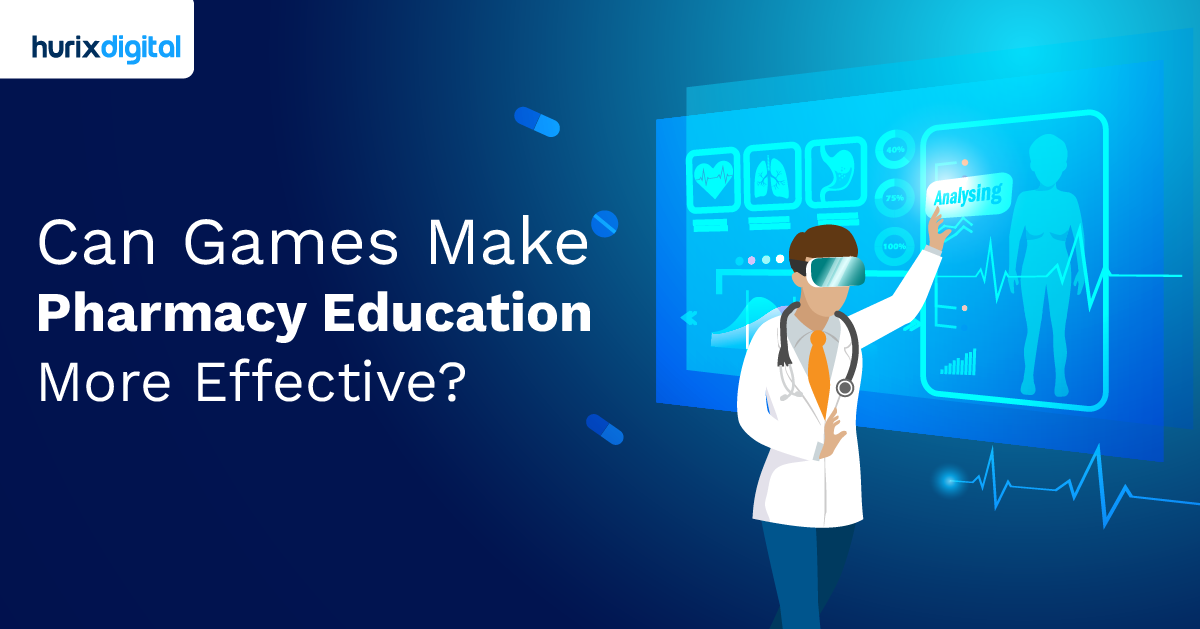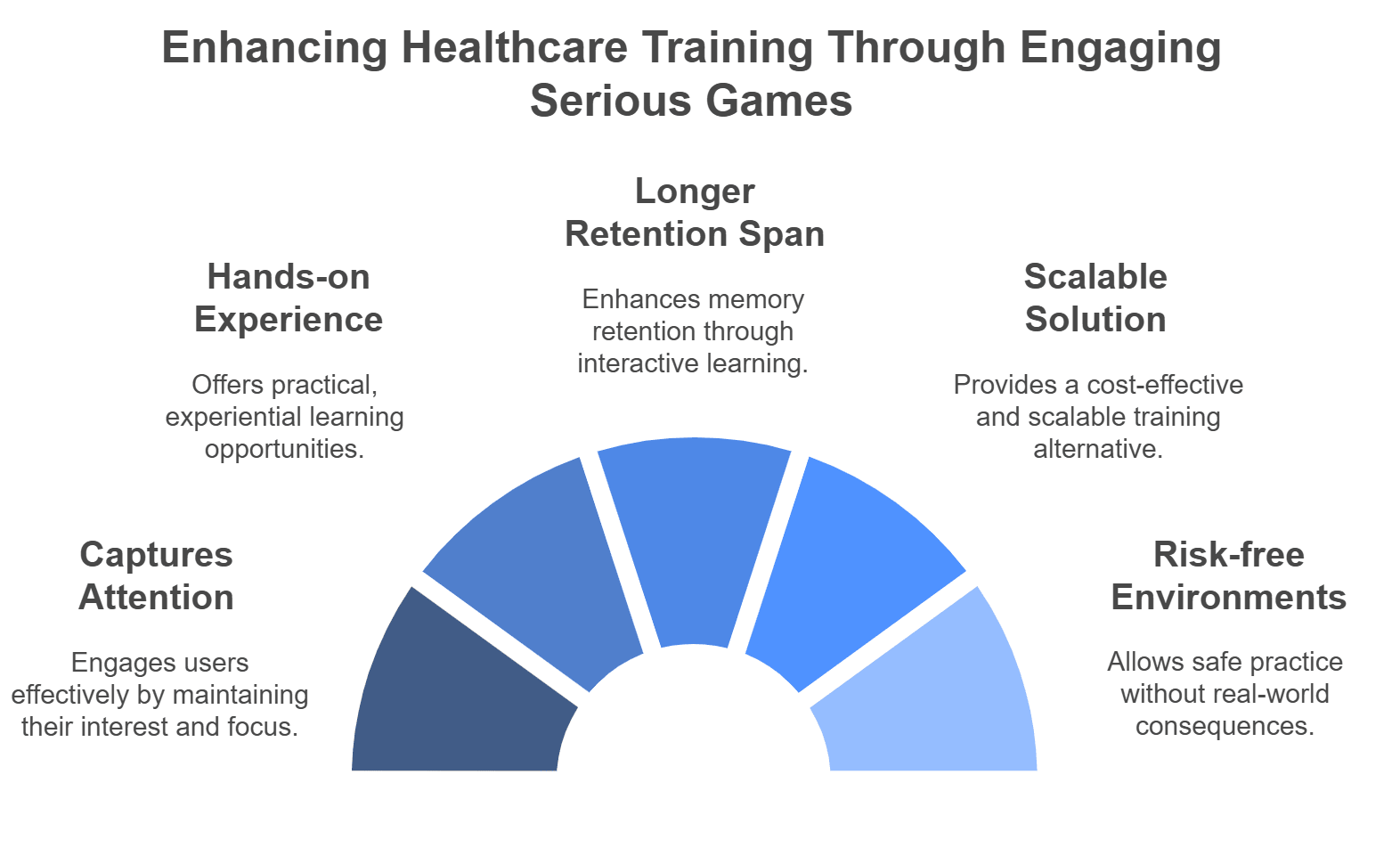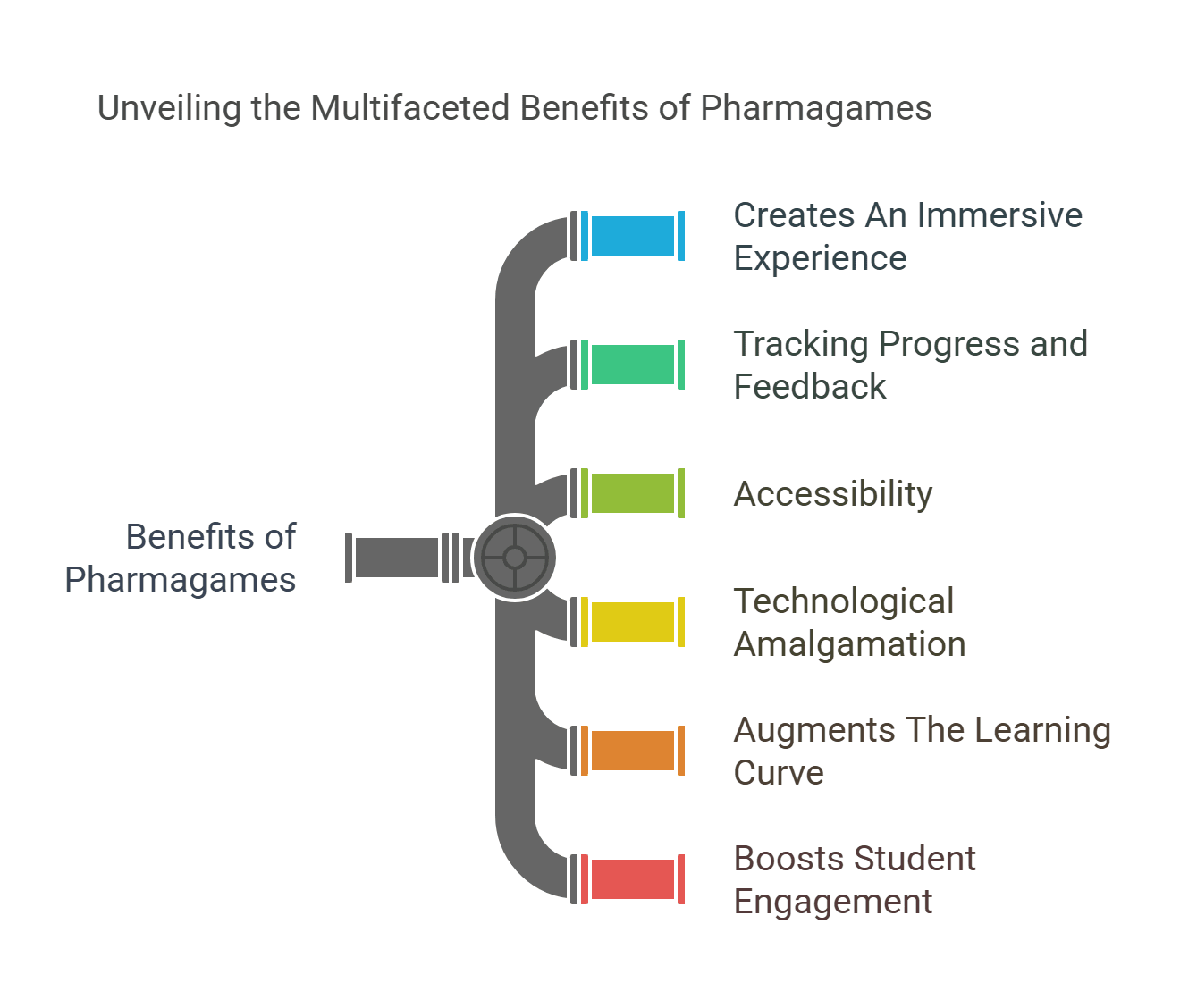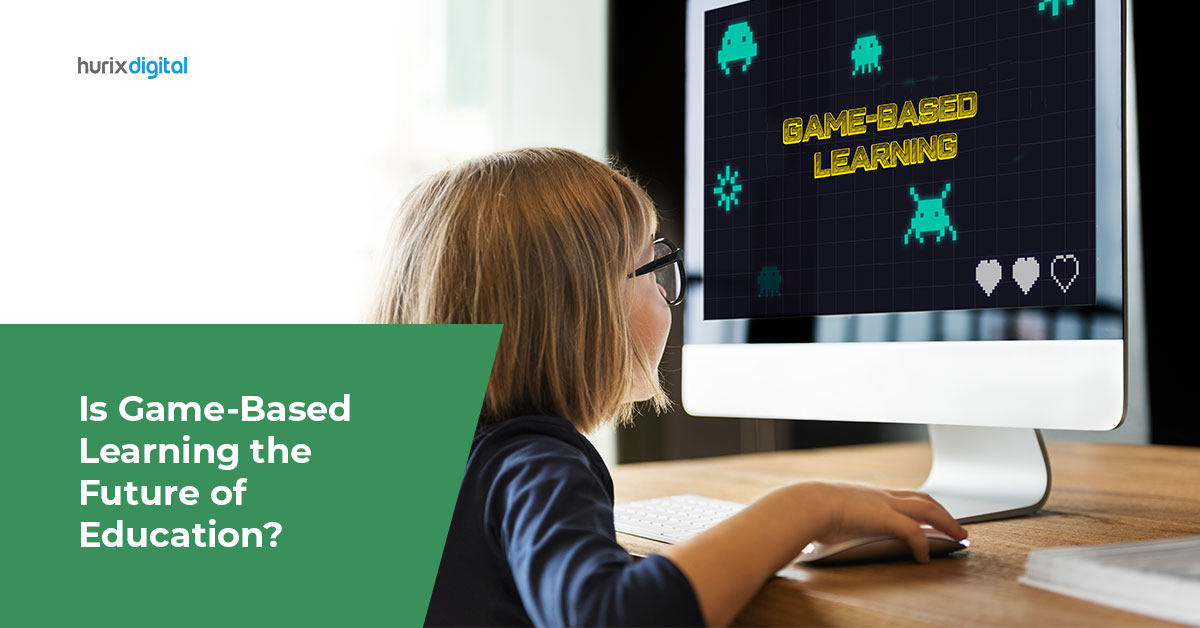
Can Games Make Pharmacy Education More Effective?
Summarize with:
According to the US Census Bureau, the healthcare industry is experiencing unprecedented growth, with the Health Care and Social Assistance sector employing the most individuals. This surge in recruitment has underscored the importance of effectively and efficiently training and educating healthcare professionals.
There was once a time when gaming was considered a distraction in the path of a student’s progress. Today, however, educational games have shown monumental changes in students’ academic development. According to the US Census Bureau, the healthcare industry is experiencing unprecedented growth, with the healthcare and social assistance sector employing the most individuals. Courses that integrated game-based learning have seen an 89.45% increase in performance compared to those that used only lecture-based models.
In this blog, we will explore the meaning of games and outline their unique advantages in medical education.
Table of Contents:
- What is Gamification?
- What are Serious Games?
- Difference Between Serious Games and Gamification
- 5 Benefits of Serious Games in Healthcare
- 4 Types of Pharmagames Available Online
- 6 Key Benefits of Pharmagames
- Conclusion
What is Gamification?
Gamification is adding design and game elements to a non-game context, such as education, business, or marketing, to increase engagement, motivation, and desired outcomes. It helps simplify learning and encourages students’ active participation through immersive features.
Gamification in pharmacology, or pharma games, is becoming increasingly recognized. The introduction of game elements provides an engaging and enjoyable way of learning and significantly improves studying outcomes.
What are Serious Games?
Traditional lecture-based learning is a more conventional teaching method. It has been used for centuries in medical studies. However, with emerging virtual simulation-based learning processes and new techniques, it has been observed that serious games can help medical students feel more immersed in the learning experience.
Unlike their entertainment-focused counterparts, Serious games are designed with a dual purpose: to entertain and educate. These games immerse students in virtual environments that simulate real-life scenarios, providing a hands-on learning experience.
This iterative process promotes a deeper understanding of the subject matter and the development of crucial decision-making skills and critical thinking abilities.
In the medical field, serious games help create real-life virtual scenarios, preventive procedures, patient interactions, etc. For instance, a simulation game might train medical professionals to handle emergencies or help students learn a new language through interactive gameplay.
Difference Between Serious Games and Gamification
Gamification and serious games are both methodologies that harness gaming principles to enhance engagement and achieve objectives, but they differ in their approach and application:
Gamification
- Gamification refers to integrating game-like elements like points, levels, and rewards into non-gaming contexts, such as education or business.
- It aims to motivate and engage users by making tasks more enjoyable and rewarding, ultimately influencing their behavior.
Serious Games
- On the other hand, serious games are full-fledged games designed with a primary purpose beyond pure entertainment.
- They are explicitly developed to address specific issues, such as educational, training, or therapeutic objectives.
- These games incorporate real-world challenges, allowing players to learn or practice skills in a safe and engaging environment.
In summary, while gamification focuses on integrating gaming elements into existing contexts to enhance motivation, serious games are standalone games designed for a specific purpose beyond entertainment.
5 Benefits of Serious Games in Healthcare
Studies show that serious games can positively trigger our motivation while learning. It gives us a sense of participation and achievement.
Let us take a look at a few ways serious games can be beneficial to learning in healthcare:
1. Captures Attention
In this era of short attention spans and constant distractions, capturing and maintaining focus requires a distinct approach.
- Serious games help convert complex topics into compelling stories that easily grab the learners’ attention.
- It taps into the player’s cognitive, social, and emotional motivations by creating different circumstances and encouraging them to participate.
- It breathes life into boring subjects and makes the learning experience fun-filled.
Medical students can practice procedural skills using a digital surgery simulation with accurate feedback, ensuring focused, engaging learning experiences.
2. Delivers Hands-on Experience
Serious games help bridge the gap between theory and practice. The players are encouraged to learn through hands-on participation by implementing their theoretical knowledge into real-life simulated situations.
For example, in a serious game designed for medical students, players might take on the role of a virtual surgeon tasked with performing a complex surgery.
- The game would simulate the steps involved in the procedure, from initial diagnosis to post-operative care.
- Students would interact with virtual patients, review their medical histories, and decide on the best course of treatment.
- Through this immersive experience, students can gain an understanding of the procedural steps involved.
Students will develop critical thinking skills as they assess treatment options and their potential outcomes.
Additionally, by receiving feedback on their decisions and actions, students can refine their skills and learn from any mistakes they make in a safe and controlled environment.
3. Has a Longer Retention Span
Traditional classroom instruction typically employs lectures, which rely heavily on auditory learning. However, serious games engage students through active participation and multi-sensory experiences, stimulating various parts of the brain.
This holistic approach to learning is known to improve information retention. According to Forbes, simulation-based learning can help increase knowledge retention by 75%. A game’s storyline, sound design, or art can trigger more senses and leave an impactful experience while learning.
For example, a student learning about anatomy through a serious game may remember the structure of the human heart more effectively by virtually dissecting it themselves rather than simply reading about it in a textbook.
4. Scalable and Cost-Effective Solution
- Serious games in medical education offer scalability, enabling courses to expand with time and incorporating additional lessons, difficulty levels, challenges, rewards, and more.
- They provide cost-effectiveness, as they can be developed once and deployed to multiple students, eliminating the need for expensive textbooks or equipment.
These factors are particularly beneficial for educational institutions with limited budgets, ensuring all students’ access to high-quality learning experiences.
5. Provides Risk-free Environments
Serious games provide a safe and controlled environment for students to perform simulated experiments under professional supervision. Students can learn at their own pace without the pressure of responding to emergencies.
In this controlled setting, they can freely experiment, make mistakes, and learn from them, all without facing the high-stakes consequences of real-world situations.
This hands-on learning approach promotes deeper understanding and effective decision-making.
4 Types of Pharmagames Available Online
Several types of pharmacy games have been introduced to pharmacy programs and have proven effective in enhancing students’ learning curves.
- Flashcards: Pharmacy education involves memorizing abbreviations of medicines, which can be made easier with flashcards. This game makes learning and remembering tricky forms easier.
- Drag and Drop: In this pharmacy game, you must drag different medicines to their uses. This classic matching game, which many of us played in our childhood, has proven to make memorizing drug names and their uses effortless.
- Quizzes: This is the most common and effective game-based education to help students boost their learning curve. Conducting quizzes helps keep track of the student’s progress and determine their growth in the subject.
- Drug Classes: Apart from digital education, some pharmacy classes can be conducted as games. This helps improve students’ academic performance due to a change in teaching methods, leaving behind the unidirectional teacher–student teaching model to incorporate gamified active learning through interactive and engaging tasks.
6 Key Benefits of Pharmagames
Let’s examine the benefits of pharma games, including enhanced education, improved adherence, and overall positive outcomes for pharmacology students.
1. Creates An Immersive Experience
Gamification in pharmacy education makes learning fun and creates an immersive experience for students. Pharmacy-based games boost students’ learning curves and increase student engagement. They also hold students’ attention and augment their knowledge.
Furthermore, these adaptive experiences can be leveraged to provide training and assess students’ knowledge through engaging tasks.
2. Tracking progress and feedback
It is well-known that feedback and progress can do wonders in pedagogy. By conducting quizzes and challenges, you can track students’ progress to give you a better understanding of their learning journey. This can give you live insights into students’ progress so that you can change your curriculum and teaching methods accordingly.
This type of data and monitoring can give you a faster analysis and a direction of scope of improvement. It will accelerate the learning process and aid in developing skills efficiently.
3. Accessibility
One of the major benefits of gamified learning is the accessibility to platforms hindered by geographical limitations. With the help of digital platforms like Hurix Digital, educators can transform their syllabi into interactive teaching models through gamification.
4. Technological Amalgamation
Gamification is a digital solution for pharmacy students to increase student engagement and knowledge retention. Integrating with state-of-the-art technology results in the best type of Pharma Games, which is guaranteed to fuel the learning curve. This can be done in the following ways:
- AI-Driven Content: Artificial intelligence and gamification work together to enable students to upskill and learn efficiently. AI helps deepen students’ knowledge and increase their responsiveness.
- AR and Gamification: Augmented reality (AR) is an immersive technology that generates digital scenarios in the real world, creating a reality where users can engage in a virtual environment without losing the authenticity of the real world. Augmented Reality can help pharmacology students enhance their understanding of complex and abstract topics by converting them into simpler and memorable ones. It increases the motivation to learn and also aids in learning from real-life scenarios by creating a deep connection between theory and application.
5. Augments The Learning Curve
Pharmacy education involves memorizing drug names, ingredients, classifications, interactions, and administrations. Traditional methods, such as rote memorization and classroom learning, can make this difficult.
Forming quizzes and gaming simulations will guarantee higher retention and accelerate the learning curve. Scenario-based learning techniques have proven to facilitate participation and aid in grasping more volume of data.
6. Boosts Student Engagement
Gamified simulations have proven to hook students’ interests and make the environment more enjoyable. Studies have shown that gamification positively affects student engagement, which has increased by 48%.
The main reason is that games turn mundane and boring syllabi into enjoyable and memorable tasks. This enables the integration of gaming and teaching, which creates a balance between enjoyment and education and triggers interest among learners.
Conclusion
Learning processes have significantly evolved in recent years, with traditional classroom-based methods giving way to game-based learning, especially in healthcare. This shift recognizes the power of interactive, experiential learning in engaging today’s students, including medical professionals.
Looking to elevate your healthcare training? Consider Hurix Digital for innovative game-based learning solutions designed to advance medical education. We collaborate closely with our clients to understand their requirements and create compelling game-based learning courses. Connect with us to learn more about our transformative solutions.
Summarize with:

Senior Vice President – Business Development
at Hurix Digital, with over 25 years of experience in EdTech and workforce learning. He excels in business development, customer relationship management, and scaling digital learning solutions, driving global growth through innovative content, simulations, and AI‑driven training offerings
 A Space for Thoughtful
A Space for Thoughtful 





